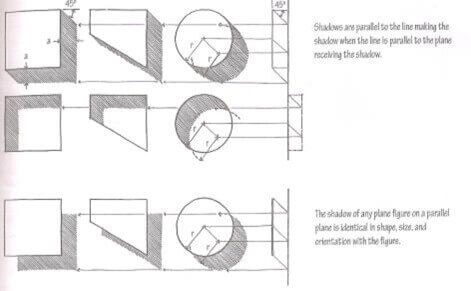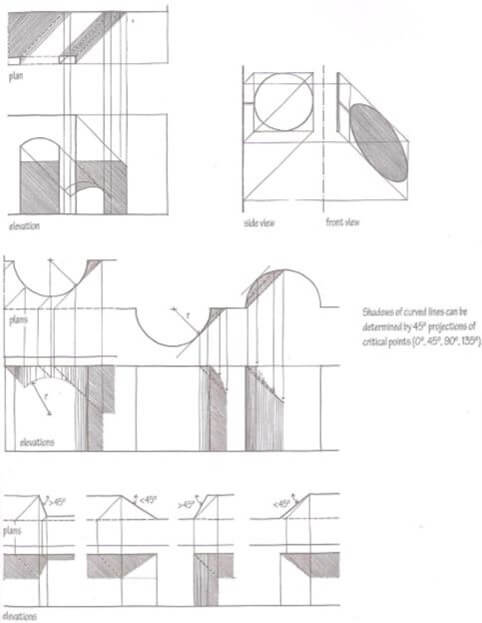Sciography Of Geometrical Assignment Help
Sciography Of Geometrical And Architectural Forms- Shades And Shadows On Building Facades
 Sciography is the study of shade and shadow in architecture. Shade and shadows are used in architectural graphics to make drawings more easily understood by expressing both the third dimension of depth and the form of surfaces, whether flat or rounded, slanted or vertical.
Sciography is the study of shade and shadow in architecture. Shade and shadows are used in architectural graphics to make drawings more easily understood by expressing both the third dimension of depth and the form of surfaces, whether flat or rounded, slanted or vertical.
The conventional direction of light is the diagonal of a cube from the top left front corner to the bottom right rear corner, so in plan and elevation views the direction of light is seen as the diagonal of a square.
This 45 degree direction of light results in shadows of widths equal to the projections from wall surfaces of vertical and horizontal shade lines.

The shape of the shadow is dependent on:
- The position of the shade line.
- The position of the observer
- The direction of light
- The form of the surface on which the plane of the shadow falls. Shadows are parallel to the line making the shadow when the line is parallel to the plane receiving the shadow.
Sciography Of Geometrical Assignment Help By Online Tutoring and Guided Sessions from AssignmentHelp.Net

The shadow of any plane figure on a parallel plane is identical in shape, size and orientation with the figure. Shadows of parallel lines are parallel when they fall on the same plane or parallel planes. To determine the shadow cast by a complex form:
Break down the complex form into its simplest geometric components.

Determine the shadows cast by these components.
The overall shadow pattern will be a composite of these shadows. A shadows profile is continuous, except where interrupted by a surface in light. A shadows profile changes direction with every change in form that receives the shadow. When the observer looks at the end of a straight line so that it is seen as a point, then the shadow cast by that line appears as a straight line, regardless of the form of the surface receiving the shadow.
The shadow of any straight line on a plane surface can be located by finding the shadows of the ends of that line.

Shadows of curved lines can be determined by 45 degree projections of critical points. The purpose of shades and shadows in the rendition of site plans is threefold:
- To indicate the height of masses above the ground plane
- To provide a contrast in value to emphasize the building form
- To indicate significant changes in topography.
Shadows are used in plan drawings to aid our perception of the depth of the space being portrayed. The intent is not to render the actual condition of sunlight at a specific point in time. The shadows cast by the cut elements and objects within the space merely give us an indication of their height above the floor or ground plane.

In section drwaings, shadows are cast by wall, floor and roof elements, which are cut, as well as by projecting elements within the space. The depth of the shadows cast by the cut elements depend on how far the cut is in front of planes receiving the shadows.


